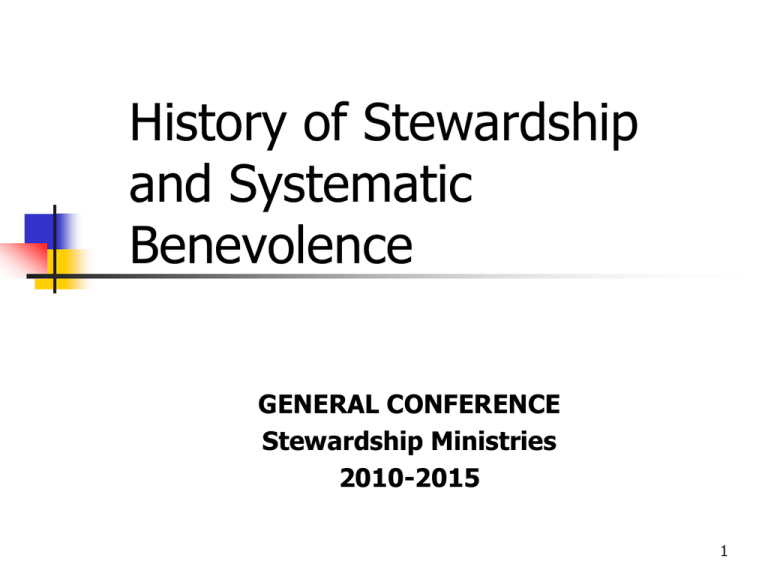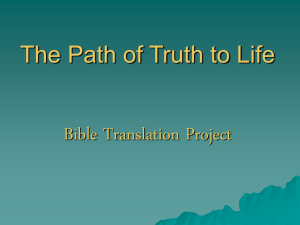- Stewardship
advertisement

History of Stewardship and Systematic Benevolence GENERAL CONFERENCE Stewardship Ministries 2010-2015 1 Welcome to a practical seminar 2 Objectives: We are going to study the history of the Stewardship Ministries Department and the systematic benevolence. 3 Objectives: This is related to the history of the Seventh-day Adventist Church, and the history of Christianity. 4 The History of Christianity Christianity was at first considered a Jewish sect. 54-68 Nero persecuted the church. 250 – Decio required an offering for the Roman gods and the emperor. 303 Dioclecian started persecuting the Christians. 313 Constantine instituted religious tolerance through the Edict of Milan. 5 History of Christianity 325 - Council of Nicaea. 1054 – The great division within the eastern and western churches. 1517 - Luther’s reformation. 534 – Calvin’s reformation. 1534 – The reformation in England. 6 Unit 1 1833 The doctrine of the end time created a spiritual revival. William Miller preached about the 2,300 days prophecy. 7 The Great Disappointment. In 1844: Christ would come. The earth would be purified. The saints would go to heaven. 8 The Reality. Christ did not come. Confusion, doubt, disappointment destroyed advent believers. The two main groups were the evangelical adventists and the Seventh-day Adventists. 9 Adventist History There was no formal organization between 1844-1854. Tent evangelism increased the attendance and also the membership. 10 The 1857 crisis. No remuneration for ministers. Some members gave financial help to the itinerant preachers. Pastor Loughborough received food and ten dollars for a four month evangelistic campaign. Pastors worked during the week in order to provide support to their families. One day’s pay was equivalent to 0.50 cents. 11 Volunteer Work. Brothers Palmer and Blacksmith gave a $5.00 gold coin to each preacher who visited their church. Thus during the years 1857 and 1858 the situation became critical, for they had no church organization and no church treasurer. 12 Effects of the Recession. . The contributions diminished drastically. The groups of believers grew but the amount of available pastors diminished. The churches cried out for pastoral help. 13 What to Do? 14 E. G White told them: They should study the Scriptures, for there they would find the solution. They named a commission made up of: J.N. Andrews J.B. Frisbie and J. White 15 Basic Points: Their report was based on the teachings of the Apostle Paul in 1 Corinthians 16:2 1. Every first day of the week (regularity). 2. Every one (participation). 3. Set aside something (provision). 4. As God prospered them (proportion) 16 Recommendation: The plan they recommended was called Systematic. Benevolence. In the beginning the plan consisted of supporting the church with weekly contributions. 17 Suggested Participation. Men: From 2-25 cents per week. Ladies: 1-10 cents per week. 18 Contribution: Those who owned property added between 1-5 cents for each $ 100 of annual increase in the value of their property. This plan of the Church in Battle Creek was published in the Review and Herald of Feb. 3, 1859. 19 1875–Consulting the Review If I earn $ 1 a day, 0.10 belongs to God. Is this money all given to Systematic Benevolence (S.B.), or can I give 5 cents to SB and the rest to other church needs? Uriah Smith’s answer was to follow the model of 02-25 or 01-10. 20 Results? Many of the members slowly adopted this plan. At the Annual Council of 1876 the principle of 10% tithe was reaffirmed. 21 1878 The General Conference voted that all conferences should send 10% of their income to the G.C. as tithe. The institutions would do the same from their gain. 22 Urgent Request. The General Conference urged the world church to set aside a weekly tithe (1879). 23 We should remember that: In the beginning systematic benevolence was a weekly contribution. After a while the idea was accepted to give a tithe as did Israel. 24 1859-1969 For 110 years the church developed in differents countries of the world. The financial support for this growth was based on tithes and offerings. 25 Structure: Churches and companies. Conference. (1860) Union. (1901) General Conference. (1863) Divisions are considered as regional offices of the G. C. 26 1966 The General Conference invited the churches to participate in: 1. A Spiritual Revival. 2. A World Evangelism, and 3. A Spirit of Sacrifice. 27 1967-Stewardship Programs: 1. For the church member based on a Systematic Benevolence. 2. For the local church based on the Combined Budget Plan. 3. For the Conference based on the Development Plan. 28 Results. The systematic benevolence within the concept of the Combined Budget greatly impacted the world church and became what we know as Personal Giving Plan (PGP) Next s 29 1969-1994 For 25 years Combined Budget Plan proved to be a blessing. In 1994 there was a Stewardship Summit in Cohutta Spring to analyze and review the systematic benevolence plan around the world. 30 World Decision: Each Division would adopt the model that they could best understand. The model that was adopted would have the official support of the respective committees. The concept of giving support to the local church, the conference and the world-wide work was consolidated. 31 Three differents options: 1. Calendar of Offerings-COO. 2. Personal Giving Plan-PGP. 3. Combined Offering-COP. 32 What’s the difference? While the tithe is treated the same way in each option, the offerings are treated differently in order to be of more practical benefit to the church in its own context. 33 Difference: In the Adventist Church the tithe is used exclusively for the proclamation of the gospel. The offerings are to promote the physical development of the church. 34 Tithes and Offerings: For the Ministries proclamat based on ion of the church gospel and interests operation and of the assumed church. needs Tithes For physical development of the church. Offerings 35 The Tithes support… The pastoral ministry. The running of the conference. Meetings, congresses and sessions. Departmental support. 36 The Offerings… Support the world missions. Help with church construction. Support the development of schools. Facilitate the functioning of the local church. Help with local church projects. 37 What is the best option? The church, with the help of the church board, should consider the advantages of the Next Different options. screen 38 What should I do? Upon receiving God’s blessings I should first of all separate the tithe. I should decide how much my offering will be. The offering could be equal to (=), greater (+) or less (-) than the tithe. I must determine what portion I will give as regular offering and what portion as special offering. 39 Remember: For the offering to be of a sweet savor to the Lord… You must bring the best to the Lord. Only God and you will know if this is the best. The offering will then be acceptable. 40 With the cheerful and voluntary support the church will continue its march to Zion. 41 History of Stewardship and Systematic Benevolence GENERAL CONFERENCE Stewardship Ministries 2010-2015 42











